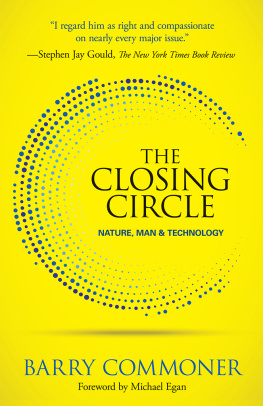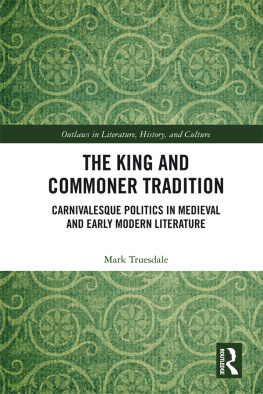Barry Commoner - The Closing Circle
Here you can read online Barry Commoner - The Closing Circle full text of the book (entire story) in english for free. Download pdf and epub, get meaning, cover and reviews about this ebook. year: 2019, publisher: Dover Publications, genre: Religion. Description of the work, (preface) as well as reviews are available. Best literature library LitArk.com created for fans of good reading and offers a wide selection of genres:
Romance novel
Science fiction
Adventure
Detective
Science
History
Home and family
Prose
Art
Politics
Computer
Non-fiction
Religion
Business
Children
Humor
Choose a favorite category and find really read worthwhile books. Enjoy immersion in the world of imagination, feel the emotions of the characters or learn something new for yourself, make an fascinating discovery.
- Book:The Closing Circle
- Author:
- Publisher:Dover Publications
- Genre:
- Year:2019
- Rating:4 / 5
- Favourites:Add to favourites
- Your mark:
- 80
- 1
- 2
- 3
- 4
- 5
The Closing Circle: summary, description and annotation
We offer to read an annotation, description, summary or preface (depends on what the author of the book "The Closing Circle" wrote himself). If you haven't found the necessary information about the book — write in the comments, we will try to find it.
The Closing Circle — read online for free the complete book (whole text) full work
Below is the text of the book, divided by pages. System saving the place of the last page read, allows you to conveniently read the book "The Closing Circle" online for free, without having to search again every time where you left off. Put a bookmark, and you can go to the page where you finished reading at any time.
Font size:
Interval:
Bookmark:



Copyright
Foreword copyright 2020 by Michael Egan
Copyright 1971 by Barry Commoner
All rights reserved.
Bibliographical Note
This Dover edition, first published in 2020, is an unabridged republication of the work originally printed by Alfred A. Knopf, New York, in 1971. The foreword has been specially prepared for this volume.
Library of Congress Cataloging-in-Publication Data
Names: Commoner, Barry, 19172012, author.
Title: The closing circle : nature, man, and technology / Barry Commoner.
Description: Mineola, New York : Dover Publications, Inc., 2020. | This Dover edition, first published in 2020, is an unabridged republication of the work originally printed by Alfred A. Knopf, New York, in 1971.Title page verso.
Identifiers: LCCN 2019003704| ISBN 9780486837468 | ISBN 0486837467
Subjects: LCSH: NatureEffect of human beings on. | Global environmental change. | Climatic changesPrevention.
Classification: LCC GF75 .C65 2020 | DDC 304.2dc23
LC record available at https://lccn.loc.gov/2019003704
Manufactured in the United States by LSC Communications
83746701
www.doverpublications.com
2 4 6 8 10 9 7 5 3 1
2020
For Lucy and Fred
CONTENTS
by Michael Egan
FOREWORD
THE CLOSING CIRCLE AND BARRY COMMONERS ENDURING HISTORICAL SIGNIFICANCE
Anyone who proposes to cure the environmental crisis undertakes thereby to change the course of history.
Barry Commoner, The Closing Circle
I n February 2019, Massachusetts Senator Edward Markey and New York House Representative Alexandria Ocasio-Cortez introduced a fourteen-page resolution for a Green New Deal. Their platform seeks to harmonize economic revitalization with the environmental realities facing the United States. In effect, the Green New Deal is a progressive declaration of a combined war on poverty and on greenhouse gas emissions. Drawing its name from President Franklin Delano Roosevelts New Deal of the Depression era and much of its inspiration from President Lyndon B. Johnsons visions of a Great Society, the green resolution proposes state-sponsored economic stimulus ventures. At the same time, it stresses green imperatives in a world where climate change has shaken confidence in traditional energy-intensive manufacturing practices to the core.
In seeking to green the economy, the Green New Deal marks a historical moment in US politics. It asserts that we have reached a point of no return in our trespasses against nature and that we need to retreat from our unquestioning destruction of the Earth. In short, the only option available to usif we are to ensure the survival of human societiesis to reverse the relationship between the economy and the environment. Rather than forcing ecological systems to acquiesce to our economic desires, we must look for new ways of transforming our economic appetites to exist within the confines of local and global ecosystems and their limits. The resolution expresses a desire to address these environmental transgressions and kick-start the US economy in a more sustainable direction.
Barry Commoners The Closing Circle is the blueprint for the Green New Deal. Even almost fifty years removed from its publication, this book remains the template for solving the global environmental crisis.
Commoner was born in Brooklyn, New York, in 1917. The son of Russian Jewish immigrants, he took an early interest in biology and enjoyed early support from family and some teachers, who saw him get to Columbia University for his undergraduate studies. Of that period, Commoner recalled, I began my career as a scientist and at the same time... learned that I was intimately concerned with politics. Inspired by left politicssupport for Spanish Loyalists and labor union movements and opposition to lynchings in the American SouthCommoner saw himself as a child of the 1930s Depression. He excelled at his studies and moved to Harvard University to pursue his PhD.
During World War II, Commoner served in the US Navy. After the war, he worked under Connecticut Senator Brien McMahon in drafting new policies for the management of the nations new nuclear weapons. At the dawn of the Cold War, Commoner was instrumental behind the scenes in ensuring that nuclear power be kept under civilian, rather than military, control. After a brief period working as an associate editor for Science Illustrated, he moved to Missouri and joined the faculty at Washington University in St. Louis, where he quickly established himself as an award-winning research scientist.
Commoner sounded an early alarm on the hazards associated with nuclear fallout, air pollution, automobile exhaust, water contamination, pesticides, phosphates, urban waste, and an assortment of other environmental dangers. By the end of the 1960s, he had emerged as the most prominent and radical voice in environmental politics. In March 1970, when Time magazine went looking for the face of American environmentalism for its cover on the eve of the first Earth Day (April 22), Commoners relative ubiquity in all corners of the environmental debate made him the compelling choice. He was, according to Time, the leader of the emerging science of survival and the Paul Revere of ecology.
Throughout his popular writing and public appearances, Commoner was an articulate and deliberate proponent for the environment. He was also principled, unwavering, and confrontational. He further recognized not just the inherent connections between the various environmental issues he addressed but also their relationship to social issues, not the least of which were peace, democracy, poverty, and health. He was equally vocal against the war in Vietnam and racial prejudice, which he saw as being consistent and in concert with his environmental sentiments.
As The Closing Circle makes clear, the environment was not a singular problem. Rather, it was (and remains) part of a much deeper social crisis. Commoner might not have been the first intellectual to draw out this more holistic relationship between nature and society, but The Closing Circle resonates for the unremitting importance of that relationship. Environmental problems cannot be resolved without commitment to social progress and social justice. Similarly, social progress and social justice are impossible without a deeper appreciation for ecological limits.
The Closing Circle was first published in 1971, in the aftermath of the first Earth Day celebration, when more than twenty million Americans took to the streets all across the country. The book outlined the nature of the environmental crisis and a pathway toward resolving it. Commoner asserted that faulty technology spurred on by a free market represented the fundamental origins of the environmental crisis. Its solution demanded reaction against the existing industrial system in order to reduce stress on ecosystems. But in making this claim, he was running up against one of the shibboleths of American culture: that economic well-being and environmental sustainability cannot coexist. Because the physical environment is the source of a nations natural wealth, the argument goes, it can be protected only at the expense of economic development. Concomitantly, the same argument asserts, environmental protections inhibit free markets. As a result, one way to read the history of the United States since industrialization in the mid-nineteenth century is to trace its resource extraction and manufacturing growth. This is a story that is implicitly familiar. It follows the mining of coal, the discovery of oil, the damming of rivers, and the deforestation to power the nation. The countrys natural wealth seemed an infinite resource. It was impossible to conceive of scarcity amid such abundance.
Font size:
Interval:
Bookmark:
Similar books «The Closing Circle»
Look at similar books to The Closing Circle. We have selected literature similar in name and meaning in the hope of providing readers with more options to find new, interesting, not yet read works.
Discussion, reviews of the book The Closing Circle and just readers' own opinions. Leave your comments, write what you think about the work, its meaning or the main characters. Specify what exactly you liked and what you didn't like, and why you think so.




